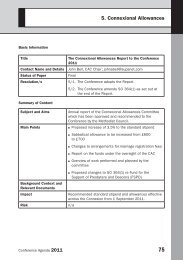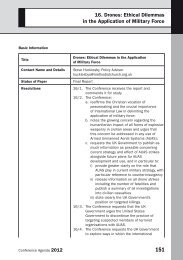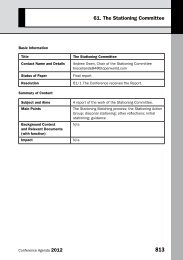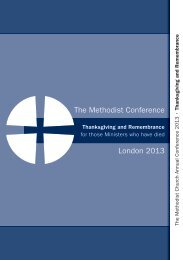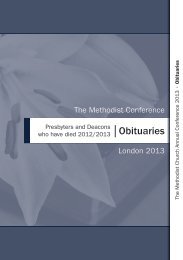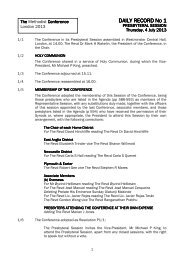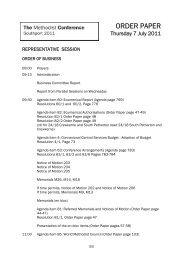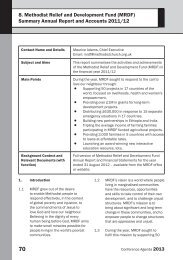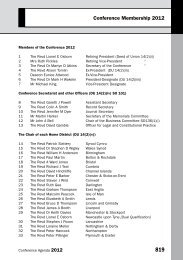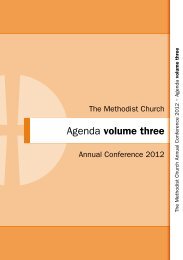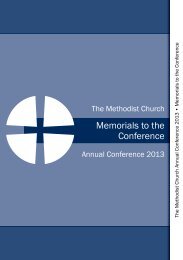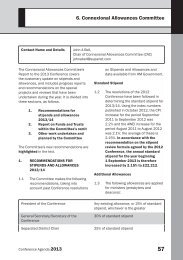Agenda Volume 2 - Methodist Conference
Agenda Volume 2 - Methodist Conference
Agenda Volume 2 - Methodist Conference
You also want an ePaper? Increase the reach of your titles
YUMPU automatically turns print PDFs into web optimized ePapers that Google loves.
35. Larger than Circuit<br />
functions and responsibilities now<br />
operate, through various forms of<br />
collaborative ministry within the<br />
District.<br />
SECTION 3 A REVIEW OF A CHANGING<br />
CONTEXT FOR DISTRICTS: WHY NOW?<br />
31. One of the points which a report such<br />
as this has to address is whether<br />
there is a need to review the current<br />
district system at all. There is a wide<br />
range of views about this, from those<br />
who see this as something long<br />
overdue and who question why it is<br />
taking so long to carry out, to those<br />
who see no need for any such review<br />
because the system is working well<br />
where they are.<br />
32. There is undoubtedly room for a wide<br />
spectrum of views as to what the<br />
conclusion of any such review might<br />
be, from the varying experience of<br />
those involved. But the <strong>Methodist</strong><br />
Council in appointing the working<br />
party took the view, which it has<br />
now affirmed, that many factors<br />
point towards embarking upon a<br />
consideration of the issues, and some<br />
of those factors are explored here.<br />
33. First, though, an introductory<br />
comment. The issue has, for a<br />
number of years, been expressed<br />
quite simply thus: “we cannot sustain<br />
thirty-one districts for very long.”<br />
“Sustainability” is a concept capable<br />
of various interpretations. The<br />
working party’s work has not been<br />
based upon a single understanding<br />
of sustainability, financial or<br />
otherwise, as a key driver for change,<br />
but in this section aspects of the<br />
‘sustainability’ issue will naturally<br />
emerge, and the section concludes<br />
by gathering together some key<br />
points.<br />
34. To return, then, to exploring the<br />
context for this review, it is relevant<br />
to take both a longer term view and<br />
also one more directly related to<br />
recent connexional developments.<br />
35. What are the long term trends which<br />
have brought about a very different<br />
picture from that of the mid-1950s<br />
when our current system largely took<br />
shape?<br />
36. First, the demographic picture<br />
cannot be ignored. As indicated<br />
above, the present configuration was<br />
based largely upon an assumption<br />
that a membership of around 30,000<br />
was the appropriate size to sustain<br />
the life of the district and an effective<br />
exercise of the Chair’s ministry. The<br />
reduction in membership and the<br />
change in the age profile of that<br />
membership, together with the<br />
reduction in the number of ministers<br />
in circuit appointments, need not<br />
be laboured here. We include in<br />
Appendix 3 a table which includes<br />
the current membership figures,<br />
and the comparative total figure for<br />
1957. Obviously membership figures<br />
do not tell the whole story but the<br />
working party took the view that it<br />
was at least a relevant indicator in<br />
providing a comparison between the<br />
two dates.<br />
376<br />
<strong>Conference</strong> <strong>Agenda</strong> 2013



